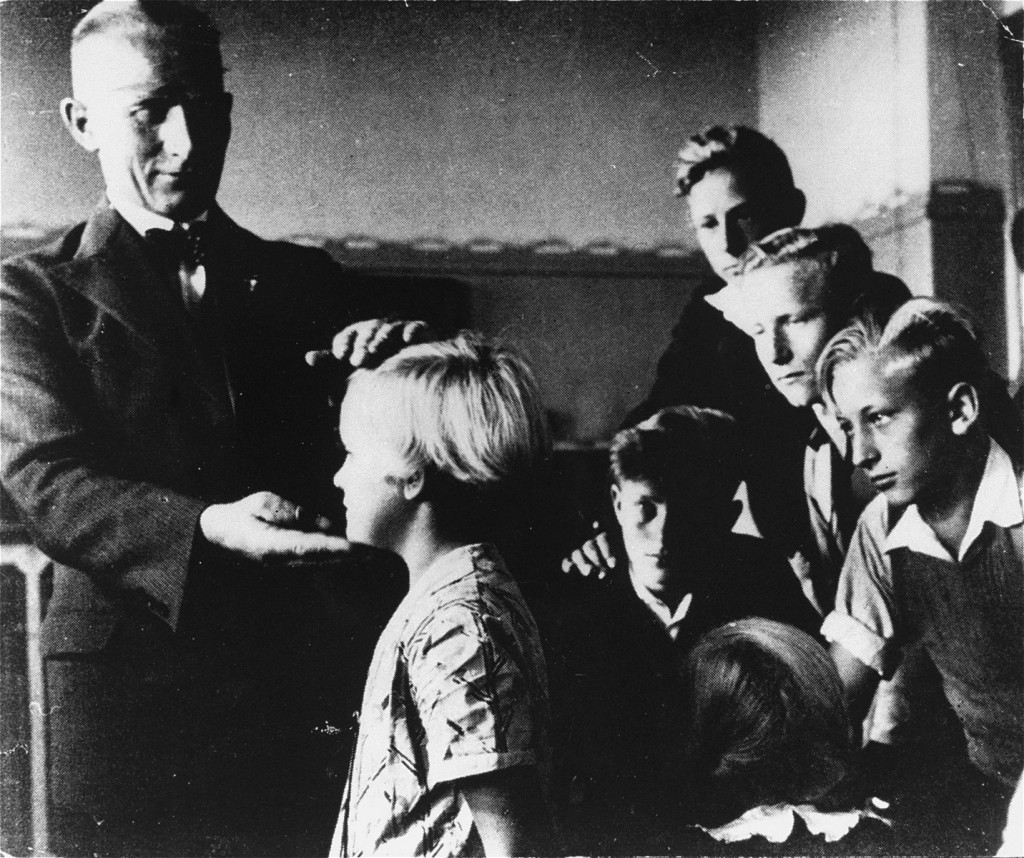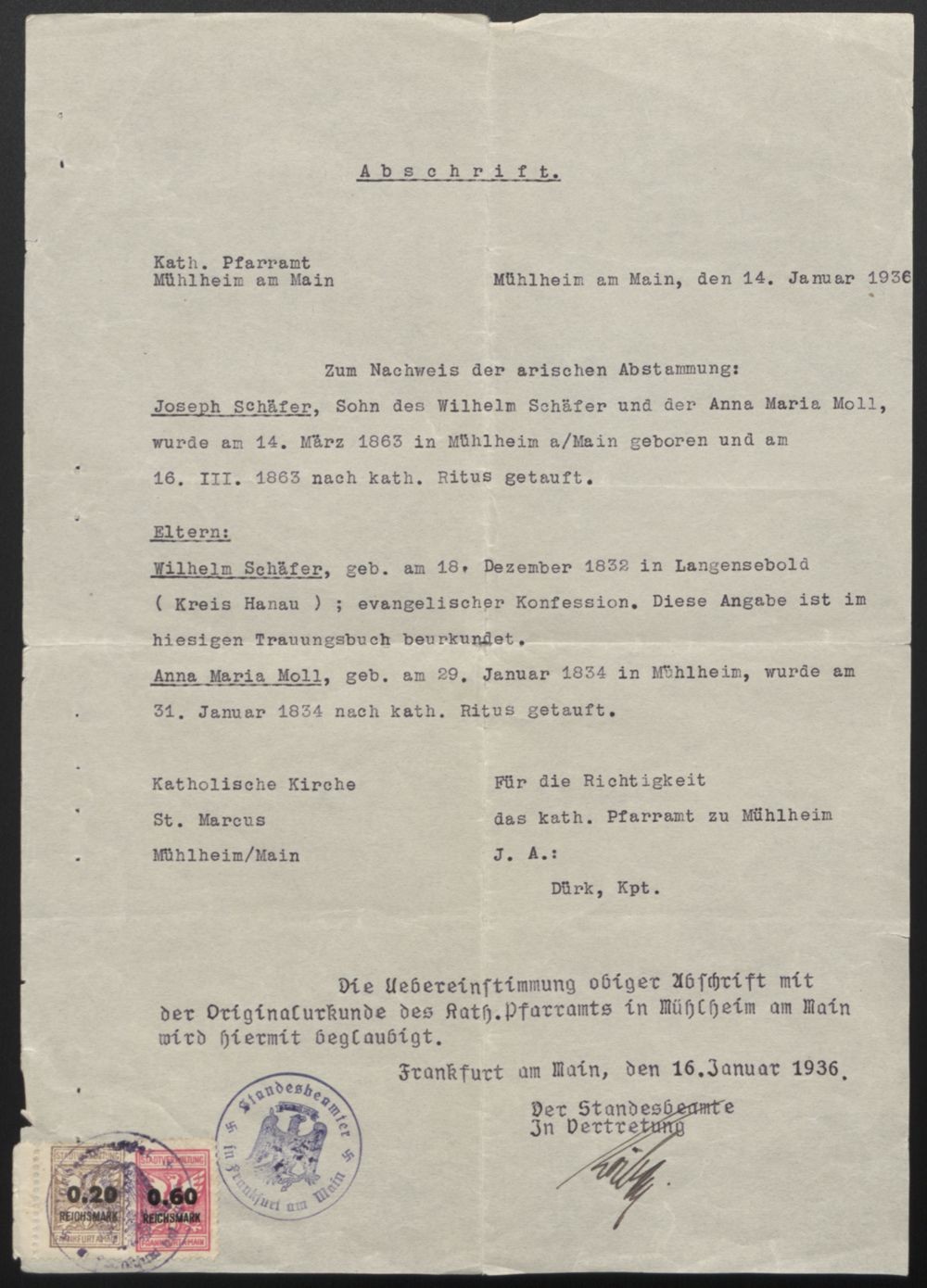
Aryan
The word Aryan has a long history. Initially, it was used to refer to groups of people who spoke a variety of related languages, including most of the European ones and several Asian ones. Over time, however, the word took on new and different meanings. In the late nineteenth and early twentieth century, some scholars and others transformed the Aryans into a mythical “race” that they claimed was superior to other races. In Germany, the Nazis promoted this false notion that glorified the German people as members of the "Aryan race." At the same time, they denigrated Jews, Black people, and Roma (Gypsies) as “non-Aryans.”
Key Facts
-
1
In Nazi Germany, the terms Aryan and non-Aryan initially were used to define who belonged to German society and who did not.
-
2
The word Aryan is an example of how words that originate as terms to describe seemingly neutral concepts can be adapted, manipulated, and radicalized for ideological or sinister purposes.
-
3
The term Aryan often was used incorrectly to describe a racial grouping of people. Aryans, however, are not a race and an "Aryan master race" does not exist.
Origins of the Term Aryan
Nineteenth-century European scholars used the term Aryan to identify the Indo-European or Indo-Germanic peoples who settled throughout India, Persia (Iran), and Europe thousands of years earlier. The classification originally described the similarities between most European languages, as well as Sanskrit and Persian (Farsi). At the same time, European scholars also identified Jews and Arabs as Semites to describe the similarities between Hebrew, Arabic, and other related languages. Later, this linguistic category was reinterpreted incorrectly as referring to ethnicity or race. Writers like the French racial theorist Arthur de Gobineau (1816-1882) specifically used the term Aryan as a racial category. They also posited that Aryans were superior to other peoples. This racial use of the term promoted a widespread, but false concept of the existence of an "Aryan race."
Use in Nazi Germany
In the early twentieth century, scholars and many others continued to use the term Aryan as a racial grouping of peoples, even though the original definition was based on the study of language structure. Some thinkers, such as Houston Stewart Chamberlain (1855-1927), promoted the idea that Aryans were racially and culturally superior to other groups of people.

From the very beginnings of the Nazi Party in the 1920s, Adolf Hitler and the ideologues of National Socialism promoted this concept. They adapted, manipulated, and radicalized the unfounded belief in the existence of an "Aryan race" and its superiority to fit their ideology and policies. Nazi officials used this concept to support the idea that Germans belonged to a "master race." Furthermore, they specified that “non-Aryan” applied foremost to Jews, who were identified as the main racial threat to German society. The term was also applied to Roma (Gypsies) and Black people.
In the early years following Hitler’s appointment as Chancellor in 1933, the term Aryan was used in various areas of public life in Nazi Germany, including in legislation. The first major law to revoke the rights of Jewish citizens was the "Law for the Restoration of the Professional Civil Service." Issued on April 7, 1933, the Civil Service Law included a clause referred to as the Arierparagraph (Aryan Paragraph). This was the first legal formulation used to exclude Jews (and often by extension other “non-Aryans”) from organizations, professions, and other aspects of public life. As the law stated, “Civil servants who are not of Aryan descent are to be retired.” Other organizations, including private or religious ones, followed suit, introducing an Aryan clause for membership.
The definition of non-Aryan, however, was broad, imprecise, and not at all “scientific.” According to the Civil Service Decree, a German could be classified as "non-Aryan" if only one grandparent was Jewish. Ironically, the Nuremberg Race Laws of September 1935 provided a much narrower legal definition of the term Jew. “Full-blooded” Jews were those who had three or four Jewish grandparents. In some cases, someone with two Jewish grandparents and who also belonged to the Jewish community could also be considered “full-blooded.”

To prove one’s "Aryan" racial status, individuals had to trace back their ancestry to 1800 or, for members of the SS, to 1750. Many Germans hired genealogists to search church, synagogue, or official bureaus of vital statistics for birth records, baptismal records, and death certificates. Once all this time-consuming research was completed, the information was submitted to the Reich Office for Kinship Research (Reichsstelle für Sippenforschung) for review.
The word Aryan proved difficult to define precisely in racial terms. Nazi race scientists disapproved of its use because it was based on linguistic similarities, not hereditary physical or intellectual characteristics. Nazi officials stopped using the terms Aryan and non-Aryan in legislation after the Nuremberg Race Laws were passed. Instead, they substituted the phrase, “those of German or related blood.” Officially, individuals of “related blood” were people of European descent. Minister of the Interior Wilhelm Frick stated that national minorities in Germany, such as Poles and Danes, were of related blood and thus eligible to be citizens. According to Nazi racial terminology, Jews, Black people, and Roma (Gypsies) were considered to be “non-European.” They were thus prohibited from becoming German citizens. In addition, they were forbidden to have sexual relations with or marry "those of German or related blood.”
Despite its murky definition, the term Aryan continued to be used in unofficial ways. Some Nazis used it to refer generally to northern Europeans. Popularly, however, it continued to be used inside and outside of Germany to refer not only to Germans, but also to other European nationalities, such as Italians, Norwegians, and Croatians. Although Poles, Russians, and some other Slavs suffered brutal persecution under Nazi rule, they were considered to be "Aryans." Race scientists and anthropologists too considered Slavs to be composed of the same races, including Nordic, as Germans. They were deemed to be of related blood.
In addition to the term Aryan being used as a noun to refer to people, the word was also used as an adjective that implied “non-Jewish." For example, the part of Warsaw outside the German-established Jewish ghetto was popularly referred to as “the Aryan side.”

The word Aryan was also the basis for another related term: Arisierung (“Aryanization”). This term described the process of confiscating and transferring Jewish businesses and property to non-Jews in Nazi Germany and German-occupied Europe.
Contemporary Usage
The word Aryan is an example of how words and concepts develop over time. In the European and American context, the term Aryan started as a scholarly concept used to describe an ancient people who spoke related languages. With time, however, Aryan referred to a racial category. The Nazi regime adopted this as a core concept in their racist ideology.
In recent decades, white supremacists across the globe have started using the word Aryan as a general label for non-Jewish, white people. The word also signifies their support for the racist beliefs and genocidal practices of Nazi Germany.
Critical Thinking Questions
Dehumanizing people through negative language has played a role in every modern genocide. How did the Nazis use language and labels to marginalize and dehumanize?
What role does language play in the escalation of discrimination, persecution, and violence?

